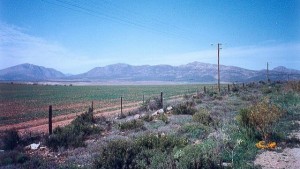 Venturing inland from Cape Town, within no time you will come across a large semi-arid region known as the Karoo. While it may just seem like a vast desolate area on a map, the Karoo is in fact one of the most fascinating parts of South Africa, from its fossils and rock formations to the unique and quirky culture, and the spring time daisy displays. If you are travelling overland through this region, make sure that you stop and smell the flowers, so to speak.
Venturing inland from Cape Town, within no time you will come across a large semi-arid region known as the Karoo. While it may just seem like a vast desolate area on a map, the Karoo is in fact one of the most fascinating parts of South Africa, from its fossils and rock formations to the unique and quirky culture, and the spring time daisy displays. If you are travelling overland through this region, make sure that you stop and smell the flowers, so to speak.
The vast space defined as the Karoo can roughly be described as the area where the old Cape province was declared. While its boundaries are not clearly defined, it covers the interior parts of the Western Cape, the Eastern Cape and the Northern Cape, and is divided into the Little (Klein) Karoo, where the Outeniqua Mountains serve as the southern boundary, and the Swartberg Mountains separate it from the Great (Groot) Karoo to the North. The Great Karoo is further divided into the Upper Karoo and the Lower Karoo.
The Karoo constitutes one of the driest parts of the country, with areas stretching into the Northern Cape receiving little more than 75ml of rain per year. However, it is not just the semi-arid climate which defines the area.
So what else makes the Karoo special?
The Landscapes
Most of the Karoo is famous among geologists thanks to the Karoo Supergroup rocks which it lies on. This supergroup consists of a mixture of sedimentary and igneous rocks which result in various rock formations dotting the otherwise vast, flat landscape. The Cape Fold Mountains in the south and the typical Karoo koppies (little hills) are great examples, while more unique variations can be spotted in the Camdeboo area outside Graaff-Reinet or the Karoo National Park outside Beaufort West.
Generally though, looking out over the Karoo is a very humbling experience, and the small shrubs, jutting mountains and iconic colour scheme is unique to the region and not something you’ll forget easily. Furthermore, the big sky is breath-taking and the sheer number of stars gives the impression of the sky pressing down on you (in the nicest way!) Furthermore, if you visit in the spring time, the Namaqua Karoo in the west is carpeted in flowers – a spectacle which visitors from around the world come to witness.
The Unique Industries
The Karoo is the heart of some of South Africa’s most important, and yet slightly obscure industries. Oudtshoorn, in the Little Karoo is the heart of the ostrich industry. Here you can ride an ostrich, taste an ostrich egg, learn about ostrich products such as leather, meat and ornamental eggs, and learn about the processes involved in producing them. Oudsthoorn is also home to the Cango Caves and offers numerous other activities.
Jansenville in the Eastern Cape is considered the hub of South Africa’s mohair industry. Most of the mohair is shipped off to Italy but some stays home to be made into socks, blankets and cardigans (as seen on Michelle Obama). The town is surrounded by Angora goat farms which provide a glimpse into typical Karoo farm life.
The Food
Although you may not necessarily know it, certain parts of the Karoo are renowned foodie hang outs! Prince Albert, which is often considered the gateway to the Great Karoo, springs to mind. Numerous wine estates, cheese-producing dairy farms and olive orchards are located in the area, making for an extraordinarily high-quality farmers’ market, and there are also cooking courses to be had!
Anyone who is a keen carnivore will also be aware of Karoo lamb, which is now a certified food, such as French Champagne. A little further south, Route 62 spots like Calitzdorp are famous for their wine and port…
The Culture
The Karoo is definitely one of the most culturally rich destinations you can imagine. Apart from the deeply entrenched and widely known culture of warm, genuine Karoo hospitality, keeping your eyes and ears open will reveal anything from typical dress like veld skoene (specific style of leather shoes), to iconic music (hard to describe but instantly recognisable).
Many towns also boast stunning old architecture, such as the Victorian-inspired buildings in Colesberg. Nieu Bethesda is home to the iconic owl house – an old home which was filled with cement and glass sculptures of owls – and Philippolis is home to an active quilting club and also hosts an annual wire car derby for the local children…
The Karoo is dotted with heritage towns, of which Graaff-Reinet is among the oldest.
Whichever way you choose to explore the Karoo and whichever part you elect to discover, you can be certain that this vibrant part of South Africa will keep you captivated for the duration of your stay!









One Response to A Guide to the Karoo and Why You Need to Go There